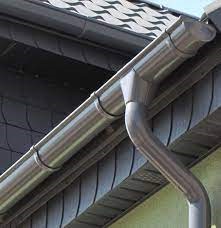 Gutters are an indispensable fixture in all homes. But while installing them properly is crucial, gutters don’t get the same level of attention as other parts of the home. Unfortunately, failing to properly install gutters is a recipe for disaster.
Gutters are an indispensable fixture in all homes. But while installing them properly is crucial, gutters don’t get the same level of attention as other parts of the home. Unfortunately, failing to properly install gutters is a recipe for disaster.
From leaking to sagging, poorly installed gutters can cause costly issues for homeowners as well as negative reviews for your business. Protecting a home from water-related damage with gutters is key to keeping a home in good condition, so focus on doing the best job for your clients and keeping their property safe.
With that in mind, we’ve put together some common mistakes to avoid when installing gutters on your next construction project. Let’s get into it.
Why Is Proper Installation Important?
If you make a living working on construction projects, your livelihood and chance of being hired for a future project rely on the success of your previous projects. Failing to properly install guttering on a home not only causes costly issues for the homeowner, but can also damage your business.
The better the job you do, the better reviews you can expect from previous customers. Plus, the happier the homeowners will be. It’s a win-win!
 Incorrect Gutter Placement
Incorrect Gutter Placement
The placement of a gutter’s downpipe (or downspouts) has a significant impact on how well the guttering system works – ditto the number of downpipes in use.
A lack of downpipes in the right places can lead to standing water or overflow during heavy rainfall. Which, let’s face it, we get a lot in Ireland!
That’s not the only issue with incorrect placement of guttering – it can actually cause the soil around the house to erode as well as damage to the foundation or siding. In fact, incorrectly positioning your downpipes can even cause a property’s basement to flood – not something you want mentioning in your business’s online reviews.
For best practice, install the gutters under or behind the drip edge of the round – the component that hangs over the roof with an outwardly projecting lower edge. That way, the water can follow the line of the drip edge before dripping directly into the gutter.
In terms of the number of downpipes, the generally accepted rule is that there should be one downpipe for every 20ft of gutter. Downpipe should be no more than 40ft apart.
Choosing the Wrong Type of Gutter
Choosing the right gutter for the home in question can be more complicated than you’d think. The design of the house, budget, and the property’s location all play a part in which material you should opt for.
Bear in mind that the steeper the roof and the rainier the climate of the property, the larger your gutter should be. Common gutter materials include steel (both stainless and galvanised), cast iron, and aluminium. The best one for the job depends on the lifespan the client is looking for and their budget. Copper gutters, for example, have the longest lifespan, but that impressive lifespan comes with a hefty price tag.
And on that note…
We know that many construction budgets come with a tight budget. That means it’s tempting to buy the cheapest products available in the hope of showing that you’ve saved the client some costs.
While staying within budget is obviously important, if you only factor price into the occasion, you might end up with sub-par materials. Instead, focus on purchasing your guttering products from a trusted supplier, with decades of experience and access to the best materials.
Improper Pitch
The point of a gutter is to direct water away from the home. If you look at a gutter, rather than being completely flat, they’re actually slightly pitched. This pitch affects how well the water drains away from the property, so it’s pretty important.
Make the pitch too steep, and rainwater will pour down it too quickly, creating overflow. Not steep enough, and the water will simply sit in the gutter without pouring where it’s meant to. Neither of these scenarios is advisable.
An easy way to ensure the pitch is correct is to slope the gutters downwards at ¼ of an inch for every 10ft of gutter. Measure correctly, and the water will run out of the gutters at exactly the right speed.
Installing Too Many Seams
While there are now options for seamless gutters, many regular gutters still have seams. But, where possible, you should keep these seams to a minimum.
Seams are particularly vulnerable to damage and water can easily leak through them, so avoid installing too many seams. Opting for a custom-made seamless gutter can be a good option, but it’s not within every homeowner’s budget, so look for other ways to use as few seams as possible.
 Poor Hanger Spacing
Poor Hanger Spacing
You’ll need to actually connect the gutters to the home and that happens with the help of gutter hangers. You can focus on installing gutters of the right size and type and at the right pitch, but your installation will still be compromised if the hangers aren’t spaced correctly. It’s a recipe for saggy gutters!
Don’t space hangers more than 2ft apart. The more rain and snow you get, the closer together you should place your hangers. This is because the weight of snow and ice can add weight to the guttering, causing it to sag more quickly than it would otherwise.
Forgetting About Gutter Guards
Guttering’s arch nemesis is debris. The more debris and vegetation falls on the guttering, the more likely it is to break, but it can also restrict the flow of water through the gutters, which means they’re not doing their job effectively.
If you’re installing gutters on a property that’s under trees or other hanging plants, the potential for debris to pile up is huge. The solution? Use gutter guards. These prevent debris from piling up on the gutter, reducing excess weight and ensuring the water can run freely.
Damage During Installation
Some guttering materials can be prone to damage during the installation process, meaning that before you’ve even placed the gutters on the new property, they’re at risk of being broken and bent. And, let’s face it, your client won’t be too happy if you can’t install their gutter because you’ve broken it!
It doesn’t take much to bend certain types of gutters – all you need is to drop them or drop something on them. If that happens, you’ll have the costly job of replacing the entire guttering. With that in mind, be careful when climbing ladders and don’t take more guttering with you than you can hold in one go.
While it’s tempting to go as quickly as possible – especially when the project is under time pressure – don’t risk ruining the guttering by doing so.
Selecting the Wrong Size
In general, the steeper the roof pitch, the larger the gutters need to be. The size of the gutter will also depend on the amount of rainfall you receive. If you live in Ireland, that’s likely to be quite a lot.
To calculate the size of gutters you need, multiply the length of your roof by the width of your roof and add the two values together. If your roof has multiple sections, calculate the square meterage of each section and add them together.
Consider the rainfall density in your region, too. If you regularly experience downpours in which a significant amount of water comes down at once, you’ll need a gutter that’s big enough to handle a sudden rush.
Working Without Adequate Precautions
When you’ve got years of experience under your belt, it can be tempting to think you’ll be fine without thorough health and safety precautions. But safety precautions are there for a reason, and if you suffer a fall during the installation process, you risk damaging not just the materials, but also yourself.
Ensure the ladder is well-balanced before climbing to reach the roof. Where possible, work with another contractor so you have somebody to look out for you and vice versa while you work.
 Not Encouraging Aftercare
Not Encouraging Aftercare
You’ve correctly chosen and installed the right kind of gutters for the job. You’ve avoided dropping them during the installation process. You’ve considered everything from the pitch to the seams to the hanger spacing. Your job’s done, right? Not quite.
The final step to a successful installation is letting your customer know what their next steps should be. All too often, homeowners have guttering installed, repaired, or replaced, only to never think about them again until a problem occurs.
Instead of leaving the client to it once you’ve finished the guttering, give them tips and advice to make the most out of their gutters and preserve them for years to come. At least four times a year, for example, (more if their home is located under a tree), homeowners should clear out their gutters to remove debris.
Likewise, a regular check of the guttering is a must, even if it’s just from ground level to look for any obvious issues. Some homeowners may even want to pay for a professional inspection to be done – this can be done as part of a roof inspection .
Either way, reiterate to your client the importance of adequate aftercare. What happens after the installation can sometimes be nearly as important as the installation itself! If you offer repair services, make sure to let the client know and leave your details with them.
Make Your Next Project Foolproof…
With the right tools for the job. A good installation starts with not only the right materials, but expert advice, too. Luckily, here at SIG, we’ve got both in abundance. We’re Ireland’s premier distributor of construction materials, including a comprehensive range of guttering to meet your needs.
As well as supplying all the materials you need to make your next project a success, our friendly team has years of experience, equipping them to best advise you on foolproof methods of installation. We offer gutters in a range of materials to suit all budgets. If you’re not sure which one is right for your needs, we’ll help you make an informed decision.
Search our range or get in touch today to find out more and guarantee success in your next project.



